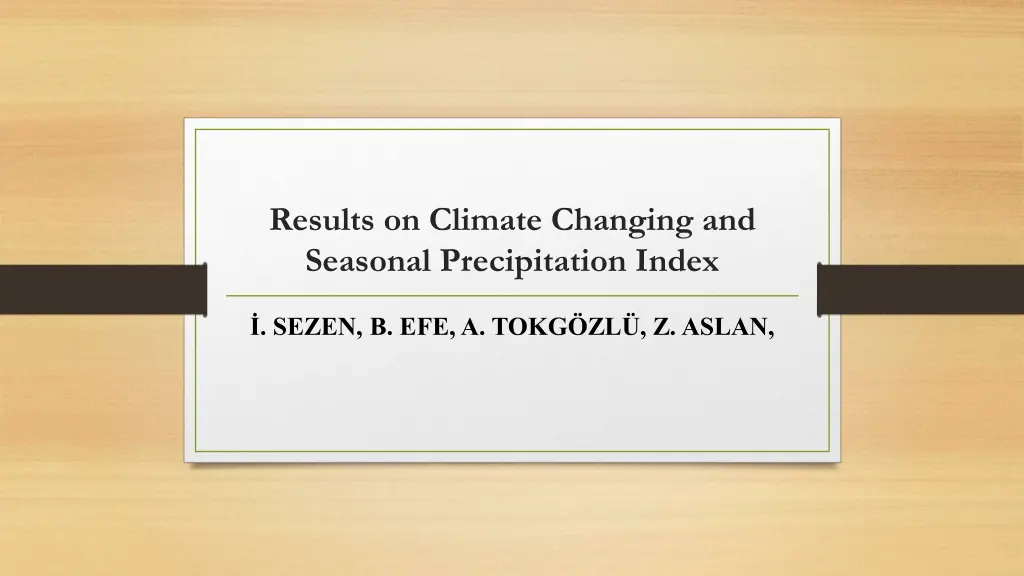
Climate Change Impacts and Drought Analysis
Today, climate change poses significant challenges globally, affecting meteorological disasters, agriculture, public health, ecosystems, and coastal regions. Understanding climate change effects, adaptation processes, and assessing impacts are crucial for adaptation. This study analyzes seasonal precipitation data from 1930 to 2023 and examines drought indices like the Standardized Precipitation Index (SPI) to evaluate drought magnitudes and classifications. By utilizing historical data and meteorological insights, the research sheds light on the implications of climate change on water resources.
Download Presentation

Please find below an Image/Link to download the presentation.
The content on the website is provided AS IS for your information and personal use only. It may not be sold, licensed, or shared on other websites without obtaining consent from the author. If you encounter any issues during the download, it is possible that the publisher has removed the file from their server.
You are allowed to download the files provided on this website for personal or commercial use, subject to the condition that they are used lawfully. All files are the property of their respective owners.
The content on the website is provided AS IS for your information and personal use only. It may not be sold, licensed, or shared on other websites without obtaining consent from the author.
E N D
Presentation Transcript
Results on Climate Changing and Seasonal Precipitation Index . SEZEN, B. EFE, A. TOKG ZL , Z. ASLAN,
Today, climate change is at the top of global problems. The adverse effects of climate change are predicted to meteorological disasters, agriculture and food security, public health, land and marine ecosystems, and coastal areas. To adapt to changing climate conditions, it is first necessary to determine the effects of climate change, understand the impacts and adaptation processes, and assess them. The last two decades have witnessed a growing water demand in developing countries. Drought has a substantial influence on water resources and irrigation. Three significant drought-type definitions are commonly used. And these are: Meteorological Drought Agricultural Drought Hydrological Drought primarily affect water resources,
Data The data were obtained from the Regional Meteorology General Directorate and precipitation data between 1930 and 2023 were considered. Totally 93 years of data were used. 12-month data sets were pre-processed. These data sets are arranged according to the type of calculation.
Drought Indices Precipitation Index The Organization (WMO) recommends that all national meteorological and hydrological services should use dry spells. Some advantages of the SPI: It requires only monthly precipitation. It can be compared across regions with markedly different climates. The standardization of the SPI allows the index to determine the rarity of a current drought. It can be created for differing periods of 1-to-36 months. The SPI method is one of the most preferred methods in determining drought. In this index, developed by McKee et al. (1993), the average rainfall in a certain period (at least 30 years) is calculated by taking the actual precipitation difference and divided by the standard deviation of the rainfall in a certain period. Standard (SPI). The World Meteorological
= average rainfall, = actual precipitation, = standard deviation. The magnitude of a drought event in a certain period (Drought Magnitude) is expressed by the following original formula: In a drought assessment made taking into account the standardized Precipitation Index values, the time in which the index is constantly negative is defined as the dry period. The first month in which the index falls below zero is considered the beginning of the drought, while the month in which the index rises to a positive value is considered the end of the drought (McKee et al., 1994), (Table 1). Drought classification was made for these results and drought classification of Tsakiris and Vangel (2004) was taken into consideration for this. These different types of droughts, the hydrological cycle, and also precipitation are the most important given the high dependence of many activities on surface water resources.
Table 1. Drought classification Meteorological Drought SPI (1-3 months) Agricultural Drought SPI (6-9 months) Hydrological Drought SPI (12-24-48 months)
This paper covers drought classification after Tsakiris ve Vangelin (2004), (Table 2). Table 2. Drought classification (Tsakiris ve Vangelis; 2004).
The reason why this index is frequently preferred is that it requires only long years of rainfall data and is easy to calculate. Many programs have been developed for the SPI method. Evaluation for December: 27 years of additional rainy period between 1944- 1971 (27); between 1971-2019 (48), 48 years of additional dry period prevailed. The very severe dry period (hydrological drought) between 1972-1975 (3), 2004-2008 (4), 2023 (1) has been effective for 8 years in 90 years in total. 5 years of severe drought, 9 years of moderate drought prevailed. After the temporal variation of rainfall, it shows that the dry period is observed after 1971.
Fig.2. Isparta province 30-year SPI 12-month calculated values Hydrological Drought
Fig. Isparta province 30-year SPI 9-month calculated values Agricultural Drought
Fig. Isparta province 30-year SPI 6-month calculated values Agricultural Drought
Fig. Isparta province 30-year SPI 3-month calculated values of meteorological drought
Fig. Isparta province 30-year SPI 1-month calculated values of meteorological drought
